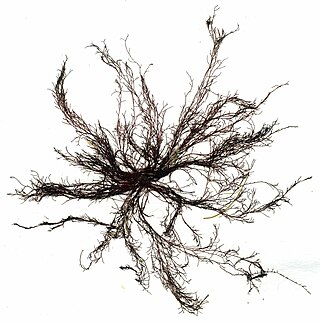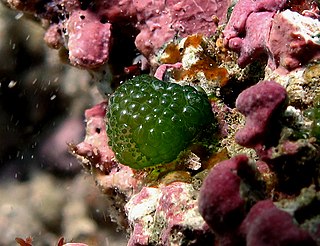
Coralline algae are red algae in the order Corallinales. They are characterized by a thallus that is hard because of calcareous deposits contained within the cell walls. The colors of these algae are most typically pink, or some other shade of red, but some species can be purple, yellow, blue, white, or gray-green. Coralline algae play an important role in the ecology of coral reefs. Sea urchins, parrot fish, and limpets and chitons feed on coralline algae. In the temperate Mediterranean Sea, coralline algae are the main builders of a typical algal reef, the Coralligène ("coralligenous"). Many are typically encrusting and rock-like, found in marine waters all over the world. Only one species lives in freshwater. Unattached specimens may form relatively smooth compact balls to warty or fruticose thalli.

Halimeda is a genus of green macroalgae. The algal body (thallus) is composed of calcified green segments. Calcium carbonate is deposited in its tissues, making it inedible to most herbivores. However one species, Halimeda tuna, was described as pleasant to eat with oil, vinegar, and salt.

Polysiphonia is a genus of filamentous red algae with about 19 species on the coasts of the British Isles and about 200 species worldwide, including Crete in Greece, Antarctica and Greenland. Its members are known by a number of common names. It is in the order Ceramiales and family Rhodomelaceae.

The ring-tailed cardinalfish is a widespread fish species in the family Apogonidae found in the Red Sea and off East Africa to Papua New Guinea, north to Japan, and south to Australia.

Bryopsis is a genus of marine green algae in the family Bryopsidaceae. It is frequently a pest in aquariums, where it is commonly referred to as hair algae.

Udotea is a genus of green algae in the family Udoteaceae.

Valonia is a genus of green algae in the Valoniaceae family. The genus Ventricaria is now regarded as a synonym of Valonia.

Turbinaria is a genus of brown algae (Phaeophyceae) found primarily in tropical marine waters. It generally grows on rocky substrates. In tropical Turbinaria species that are often preferentially consumed by herbivorous fishes and echinoids, there is a relatively low level of phenolics and tannins.
Arnarvon Islands are a group of islands in Solomon Islands. They are located in Isabel Province and nearby to Wagina Island in Choiseul Province.

The Phoenix Islands Protected Area (PIPA) is located in the Republic of Kiribati, an ocean nation in the central Pacific approximately midway between Australia and Hawaii. PIPA constitutes 11.34% of Kiribati's exclusive economic zone (EEZ), and with a size of 408,250 km2 (157,630 sq mi), it is one of the largest marine protected areas (MPA) and one of the largest protected areas of any type on Earth. The PIPA was also designated as the world's largest and deepest UNESCO World Heritage Site in 2010.

Hydroclathrus is a genus of perforate brown alga, of the phylum Ochrophyta and the class Phaeophyceae.

Asparagopsis is a genus of edible red macroalgae (Rhodophyta). The species Asparagopsis taxiformis is found throughout the tropical and subtropical regions, while Asparagopsis armata is found in warm temperate regions. Both species are highly invasive, and have colonised the Mediterranean Sea. A third accepted species is A. svedelii, while others are of uncertain status.

Coral bleaching in Oahu has been on the rise since 1996, when Hawaii's first major coral bleaching occurred in Kaneohe Bay, followed by major bleaching events in the Northwest islands in 2002 and 2004. In 2014, biologists from the University of Queensland observed the first mass bleaching event, and attributed it to The Blob.

The Coral reefs of the Solomon Islands consists of six major islands and over 986 smaller islands, in Oceania, to the east of Papua New Guinea and northwest of Vanuatu. The Solomon Islands lie between latitudes 5° and 13°S, and longitudes 155° and 169°E. The distance between the westernmost and easternmost islands is about 1,500 km (930 mi). The Santa Cruz Islands are situated north of Vanuatu and are especially isolated at more than 200 km (120 mi) from the other islands. The Solomon Islands has the 22nd largest Exclusive Economic Zone of 1,589,477 km2 (613,701 sq mi) of the Pacific Ocean.
Crustaphytum is a genus of red alga first discovered in Taoyuan algal reefs by Taiwanese scientists. The epithet “crusta” refers to crustose thallus and “phytum” refers to plant. Belonging to the family Hapalidiaceae in the order Hapalidiales, Crustaphytum is one kind of crustose coralline algae.
Mesospora negrosensis is a species of macroalga occurring in the western Atlantic.
Mesospora is a genus of macroalgae that was described by Anna Weber-van Bosse in 1911. Although considered a taxonomic synonym of Hapalospongidion, the World Register of Marine Species cites six accepted species of the genus.

Dictyosphaeria cavernosa is a species of green algae in the family Siphonocladaceae, one of the three species in this family. Its common name is green bubble seaweed.

Dictyosphaeria versluysii is a species of green algae in the family Siphonocladaceae. This species is indigenous to Indonesia, with a world distribution ranging from the Pacific regions and extending to the Indian Ocean. It can be found in various countries including Mexico, China, Thailand, Vietnam, the Philippines, Australia, and Hawaii.
















